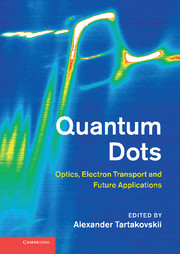Book contents
- Frontmatter
- Contents
- List of contributors
- Preface
- Part I Nanostructure design and structural properties of epitaxially grown quantum dots and nanowires
- Part II Manipulation of individual quantum states in quantum dots using optical techniques
- Part III Optical properties of quantum dots in photonic cavities and plasmon-coupled dots
- 8 Deterministic light–matter coupling with single quantum dots
- 9 Quantum dots in photonic crystal cavities
- 10 Photon statistics in quantum dot micropillar emission
- 11 Nanoplasmonics with colloidal quantum dots
- Part IV Quantum dot nano-laboratory: magnetic ions and nuclear spins in a dot
- Part V Electron transport in quantum dots fabricated by lithographic techniques from III–V semiconductors and graphene
- Part VI Single dots for future telecommunications applications
- Index
- References
10 - Photon statistics in quantum dot micropillar emission
from Part III - Optical properties of quantum dots in photonic cavities and plasmon-coupled dots
Published online by Cambridge University Press: 05 August 2012
- Frontmatter
- Contents
- List of contributors
- Preface
- Part I Nanostructure design and structural properties of epitaxially grown quantum dots and nanowires
- Part II Manipulation of individual quantum states in quantum dots using optical techniques
- Part III Optical properties of quantum dots in photonic cavities and plasmon-coupled dots
- 8 Deterministic light–matter coupling with single quantum dots
- 9 Quantum dots in photonic crystal cavities
- 10 Photon statistics in quantum dot micropillar emission
- 11 Nanoplasmonics with colloidal quantum dots
- Part IV Quantum dot nano-laboratory: magnetic ions and nuclear spins in a dot
- Part V Electron transport in quantum dots fabricated by lithographic techniques from III–V semiconductors and graphene
- Part VI Single dots for future telecommunications applications
- Index
- References
Summary
Introduction
The ever-growing demand for fast optical data transmission calls for lasers offering high modulation rates and low energy consumption at the same time. Advances in growth and processing methods make quantum dot (QD) based lasers better candidates for this challenge than ever before. Placed in microresonators able to confine light in regions roughly the size of their wavelength, QDs pave the way to ultra-low threshold lasing. The most common resonator geometries aimed at three-dimensional light confinement are microdisks, photonic crystal membrane cavities and micropillars. The latter are especially good candidates for realizing microlasers suitable for applications as they offer directed emission and allow for parallel device processing. However, this increased efficiency also results in modified emission properties of QD lasers [8]. Semiconductor-specific processes like Pauli-blocking of states, the composite nature of the carriers involved and Coulomb interactions between carriers cause deviations from the standard atomistic laser picture. The main aim of our studies is to characterize microlaser emission in terms of photon statistics and coherence properties. Following Glauber, the most detailed description of a light field is given in a series of correlation functions describing coherence in different orders [10].
This chapter is organized as follows. Section 10.2 contains a brief review on the characteristic properties of micropillar lasers and discusses the emission properties of microlasers operated below and above threshold. Section 10.2.1 focuses on photon statistics and the classification of light fields.
- Type
- Chapter
- Information
- Quantum DotsOptics, Electron Transport and Future Applications, pp. 169 - 184Publisher: Cambridge University PressPrint publication year: 2012



